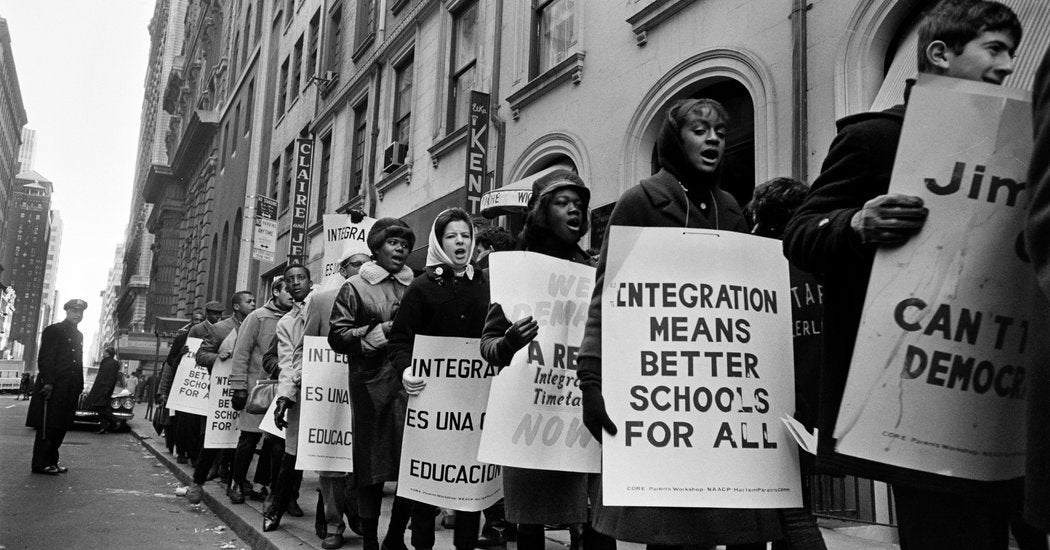School Desegregation: The End Of An Era? Examining The Justice Department's Decision

Table of Contents
The History of School Desegregation and the Role of the Justice Department
The history of school desegregation in the United States is a long and complex one, marked by both significant progress and persistent setbacks. The landmark Brown v. Board of Education Supreme Court decision in 1954 declared state laws establishing separate public schools for black and white students to be unconstitutional. This ruling, however, did not immediately lead to widespread desegregation. Massive resistance from many Southern states, coupled with a slow and often inadequate enforcement of the ruling, resulted in decades of legal battles and social upheaval.
The Justice Department played – and continues to play – a crucial role in enforcing desegregation. Following the Civil Rights Act of 1964, the DOJ significantly increased its efforts to desegregate schools, filing numerous lawsuits and issuing directives to school districts. However, the effectiveness of these interventions varied widely across the country. Key Supreme Court cases, such as Milliken v. Bradley (1974), further shaped the legal landscape of desegregation efforts, often limiting the scope of federal intervention.
- Brown v. Board of Education (1954): Declared state-sponsored segregation in public schools unconstitutional.
- The Civil Rights Act of 1964: Provided legal tools for the federal government to combat school segregation.
- Milliken v. Bradley (1974): Limited the scope of desegregation remedies to encompass only those school districts found to have engaged in de jure segregation.
- Key DOJ interventions and their outcomes: While the DOJ achieved success in some areas, widespread de facto segregation – segregation resulting from residential patterns and other factors – remains a significant challenge.
The Justice Department's Recent Shift in Policy
In recent years, the Justice Department has noticeably shifted its approach to school desegregation cases. This shift has involved a reduction in the number of new desegregation lawsuits filed, a decrease in enforcement of existing desegregation orders, and a general de-emphasis on proactive measures to address racial imbalances in schools. While the official rationale behind these policy changes may vary, critics argue it represents a retreat from the commitment to actively dismantling segregation in education.
- Specific examples of recent DOJ decisions: [Insert specific examples of recent decisions and their outcomes. This section needs concrete examples to be impactful and SEO-friendly. Include links to relevant news articles or official documents where possible].
- Changes in enforcement priorities: The DOJ may now prioritize other areas of civil rights enforcement over school desegregation.
- Statements from the DOJ regarding their policy shift: [Include direct quotes or paraphrases from official DOJ statements explaining their policy rationale. Link to relevant sources].
The Impact on Affected Communities
The Justice Department's policy shift has significant implications for diverse communities across the nation. The potential for increased racial segregation in schools is a major concern. This re-segregation would likely exacerbate existing inequalities in educational resources, teacher quality, and student achievement. The disproportionate impact on minority student populations is particularly troubling, potentially widening the achievement gap and perpetuating systemic inequalities.
- Impact on minority student populations: Minority students, particularly African American and Hispanic students, are disproportionately affected by school segregation, experiencing lower academic performance and fewer opportunities.
- Concerns about re-segregation in specific school districts: [Cite specific examples of school districts experiencing increased segregation following the DOJ policy shift. Include data on racial demographics and achievement gaps].
- Potential effects on educational outcomes: Studies consistently show that racially segregated schools often have lower academic achievement rates for minority students.
Arguments For and Against the Justice Department's Decision
Proponents of the Justice Department's shift argue that it promotes local control over education and reduces federal overreach. They contend that school districts are best positioned to address the unique needs of their communities. However, critics argue that this approach effectively abandons the federal government's responsibility to ensure equal educational opportunities for all students, regardless of race. They warn that it may lead to increased segregation and perpetuate systemic inequalities.
- Arguments supporting the DOJ's stance (e.g., local control): Advocates for local control often highlight the diversity of educational needs and preferences across communities.
- Arguments opposing the DOJ's stance (e.g., perpetuation of inequality): Critics emphasize the historical and ongoing reality of systemic racism in education and the need for robust federal oversight.
- Expert opinions from legal scholars and educators: Include quotes and citations from legal experts and educators who offer diverse perspectives on the issue.
Conclusion
The Justice Department's decisions on school desegregation are fraught with complexity, raising profound questions about the ongoing struggle for racial equality in education. The potential for increased school segregation, with its associated negative impacts on student achievement and educational equity, remains a serious concern. While the arguments for local control hold merit, they must be weighed against the imperative to ensure equal educational opportunities for all children.
The future of school desegregation remains uncertain. Continued monitoring of the Justice Department's actions and active engagement in advocating for equitable educational opportunities are crucial. Stay informed about developments in school desegregation and continue to advocate for policies that promote racial justice and educational equality for all children. We must continue the fight for meaningful school desegregation to ensure that the promise of Brown v. Board of Education is finally fulfilled for every child.

Featured Posts
-
 M M A 600
May 03, 2025
M M A 600
May 03, 2025 -
 Glastonbury Headliners 2024 Speculation Mounts Around The 1975 And Olivia Rodrigo
May 03, 2025
Glastonbury Headliners 2024 Speculation Mounts Around The 1975 And Olivia Rodrigo
May 03, 2025 -
 Situatsiya Vokrug Makronov Reaktsiya Zakharovoy
May 03, 2025
Situatsiya Vokrug Makronov Reaktsiya Zakharovoy
May 03, 2025 -
 Five Threats To Reform Uks Political Future An Analysis
May 03, 2025
Five Threats To Reform Uks Political Future An Analysis
May 03, 2025 -
 Canadas Youth Mental Health Crisis A Global Commissions Recommendations
May 03, 2025
Canadas Youth Mental Health Crisis A Global Commissions Recommendations
May 03, 2025
Latest Posts
-
 Investment In Belgian Energy A 270 M Wh Bess Financing Case Study
May 04, 2025
Investment In Belgian Energy A 270 M Wh Bess Financing Case Study
May 04, 2025 -
 Belgiums Energy Market Financing Options For A 270 M Wh Bess
May 04, 2025
Belgiums Energy Market Financing Options For A 270 M Wh Bess
May 04, 2025 -
 Challenges And Solutions Financing A 270 M Wh Bess In Belgium
May 04, 2025
Challenges And Solutions Financing A 270 M Wh Bess In Belgium
May 04, 2025 -
 Securing Funding For A 270 M Wh Bess Project In The Belgian Merchant Market
May 04, 2025
Securing Funding For A 270 M Wh Bess Project In The Belgian Merchant Market
May 04, 2025 -
 270 M Wh Battery Energy Storage System Bess Financing In Belgium
May 04, 2025
270 M Wh Battery Energy Storage System Bess Financing In Belgium
May 04, 2025
